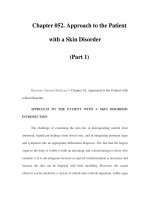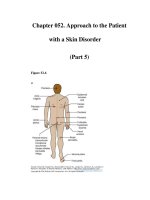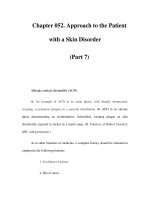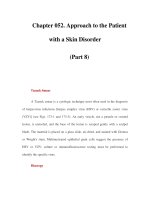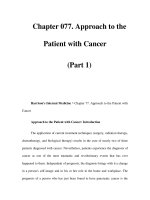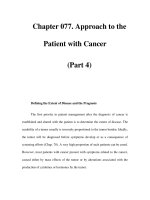Chapter 077. Approach to the Patient with Cancer (Part 4) pps
Bạn đang xem bản rút gọn của tài liệu. Xem và tải ngay bản đầy đủ của tài liệu tại đây (16.61 KB, 6 trang )
Chapter 077. Approach to the
Patient with Cancer
(Part 4)
Defining the Extent of Disease and the Prognosis
The first priority in patient management after the diagnosis of cancer is
established and shared with the patient is to determine the extent of disease. The
curability of a tumor usually is inversely proportional to the tumor burden. Ideally,
the tumor will be diagnosed before symptoms develop or as a consequence of
screening efforts (Chap. 78). A very high proportion of such patients can be cured.
However, most patients with cancer present with symptoms related to the cancer,
caused either by mass effects of the tumor or by alterations associated with the
production of cytokines or hormones by the tumor.
For most cancers, the extent of disease is evaluated by a variety of
noninvasive and invasive diagnostic tests and procedures. This process is called
staging. There are two types. Clinical staging is based on physical examination,
radiographs, isotopic scans, CT scans, and other imaging procedures; pathologic
staging takes into account information obtained during a surgical procedure,
which might include intraoperative palpation, resection of regional lymph nodes
and/or tissue adjacent to the tumor, and inspection and biopsy of organs
commonly involved in disease spread. Pathologic staging includes histologic
examination of all tissues removed during the surgical procedure. Surgical
procedures performed may include a simple lymph node biopsy or more extensive
procedures such as thoracotomy, mediastinoscopy, or laparotomy. Surgical staging
may occur in a separate procedure or may be done at the time of definitive surgical
resection of the primary tumor.
Knowledge of the predilection of particular tumors for spread to adjacent or
distant organs helps direct the staging evaluation.
Information obtained from staging is used to define the extent of disease
either as localized, as exhibiting spread outside of the organ of origin to regional
but not distant sites, or as metastatic to distant sites. The most widely used system
of staging is the TNM (tumor, node, metastasis) system codified by the
International Union Against Cancer and the American Joint Committee on Cancer
(AJCC). The TNM classification is an anatomically based system that categorizes
the tumor on the basis of the size of the primary tumor lesion (T1–4, where a
higher number indicates a tumor of larger size), the presence of nodal involvement
(usually N0 and N1 for the absence and presence, respectively, of involved nodes,
although some tumors have more elaborate systems of nodal grading), and the
presence of metastatic disease (M0 and M1 for the absence and presence,
respectively, of metastases). The various permutations of T, N, and M scores
(sometimes including tumor histologic grade G) are then broken into stages,
usually designated by the roman numerals I through IV. Tumor burden increases
and curability decreases with increasing stage. Other anatomic staging systems are
used for some tumors, e.g., the Dukes classification for colorectal cancers, the
International Federation of Gynecologists and Obstetricians (FIGO) classification
for gynecologic cancers, and the Ann Arbor classification for Hodgkin's disease.
1
Certain tumors cannot be grouped on the basis of anatomic considerations.
For example, hematopoietic tumors such as leukemia, myeloma, and lymphoma
are often disseminated at presentation and do not spread like solid tumors. For
these tumors, other prognostic factors have been identified (Chaps. 104, 105, and
106).
In addition to tumor burden, a second major determinant of treatment
outcome is the physiologic reserve of the patient. Patients who are bedridden
before developing cancer are likely to fare worse, stage for stage, than fully active
patients. Physiologic reserve is a determinant of how a patient is likely to cope
with the physiologic stresses imposed by the cancer and its treatment. This factor
is difficult to assess directly. Instead, surrogate markers for physiologic reserve are
used, such as the patient's age or Karnofsky performance status (Table 77-4).
Older patients and those with a Karnofsky performance status <70 have a poor
prognosis unless the poor performance is a reversible consequence of the tumor.
Table 77-4 Karnofsky Performance Index
Performance
Status
Functional Capability of the Patient
100 Normal; no complaints; no evidence of disease
90
Able to carry on normal activity; minor signs or
symptoms of disease
80
Normal activity with effort; some signs or
symptoms of disease
70 Cares for self; unable to carry on norma
l activity
or do active work
60
Requires occasional assistance but is able to care
for most needs
50
Requires considerable assistance and frequent
medical care
40 Disabled; requires special care and assistance
30 Severely disabled; hospitalization is i
ndicated
although death is not imminent
20
Very sick; hospitalization necessary; active
supportive treatment is necessary
10 Moribund, fatal processes progressing rapidly
0 Dead
Increasingly, biologic features of the tumor are being related to prognosis.
The expression of particular oncogenes, drug-resistance genes, apoptosis-related
genes, and genes involved in metastasis are being found to influence response to
therapy and prognosis. The presence of selected cytogenetic abnormalities may
influence survival. Tumors with higher growth fractions, as assessed by expression
of proliferation-related markers such as proliferating cell nuclear antigen (PCNA),
behave more aggressively than tumors with lower growth fractions. Information
obtained from studying the tumor itself will increasingly be used to influence
treatment decisions. Host genes involved in drug metabolism can influence the
safety and efficacy of particular treatments.
1
The AJCC Manual for Staging Cancer, 5th edition, can be obtained from
the AJCC at 55 East Erie Street, Chicago, IL, 60611.
